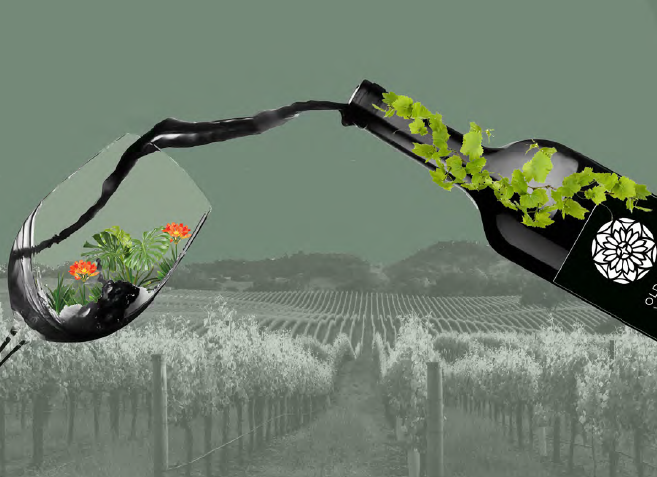by Mina Burns
In Sonoma County, wine growers and makers alike are turning over a new leaf: sustainability in winemaking. The county’s vineyards have a 99% sustainability certification—making it the most sustainable winegrowing region in the world.
Sonoma County, in Northern California’s “wine country,” is a premier wine-growing region which contains 425 wineries. Spanning from the Pacific Coast to the Mayacamas Mountains in the east, this area is one of the largest wine producers in the state, with over 63,000 acres of vineyards.
In 2014, Sonoma County Winegrowers—made up of over 1,800 winegrape growers—set a goal to become the nation’s first 100% certified sustainable wine region. Since then, Sonoma wineries passed various sustainability checks and are maintaining winegrape growing and winemaking processes that follow these principles: sensitivity to the environment, continuation of economic feasibility, and production of high-quality wines.
Sonoma County Winegrowers are piloting the Climate Adaptation Certification (CAC) program, which is a customized farm plan to monitor the impact of climate friendly agricultural practices. In this plan, each vineyard creates its own land management program involving the absorption of nitrous oxide and carbon emissions from the atmosphere into the soil. Farmers can employ methods like mulching, composting, rotating livestock, and using cover crops to carry out the sequestration of greenhouse gases.
“If you find a good cover crop, then you can actually build up organic content in the soil. You’re essentially creating topsoil; you’re capturing carbon out of the atmosphere and incorporating it into the soil. If everybody did that on all farms, on a major scale, we could take a lot of CO2 out of the atmosphere,” said UC Davis Professor of Viticulture and Enology, Andrew Waterhouse, weighing in on carbon sequestration in vineyards.
Since the CAC program’s implementation in January 2020, twenty winegrowers have participated, with results showing that up to 2,000 metric tons of carbon dioxide can be removed annually from the atmosphere for the 1,900 vineyard acres that were involved. To the Sonoma County Winegrowers, the program is a promising step forward in vineyard sustainability.
Growers note that these carbon sequestration methods have other agricultural benefits as well. Darek Trowbridge, the owner of Old World Winery in Fulton, California, is piloting a new system of carbon removal by using wood chip mulch as a farming input.
“I’ve built up the carbon in my soils with composted mulch and . . . that brings microbiology back to the soil, heals the soil, allows us to hold water and for water to percolate through that soil.” In order to increase productivity of the land, Trowbridge explained “you have to bring the carbon content in the soil up.”
Beyond carbon emissions, another significant source of vineyard greenhouse gas emissions is the use of nitrogen fertilizers. When soil is exposed to nitrogen in its active form, as in fertilizer, soil bacteria releases nitrogen back into the atmosphere. Timing nitrogen applications to ensure maximum uptake by roots is one way to decrease N2O emissions.
Other ways that the winegrowers are minimizing their environmental impact include using sheep and birds to control weeds and pests instead of using pesticides, composting excess vegetation, and preserving local ecosystems and wildlife habitats when possible.
In California, water use is another important consideration. Wineries typically use between 2.5 and 6 gallons of water to create 1 gallon of wine, and this is without accounting for irrigation water and other uses.
Many wineries are beginning to utilize the practice of dry farming, in which winegrapes are not irrigated at all, but instead rely on the natural rainfall of the region. Vines that are subjected to this method typically develop deeper root systems than irrigated vineyards and can continue to draw upon deeper sources of water even during times of drought. As a result, they can often live much longer than their human-irrigated counterparts.
“Irrigated, fertilized vineyards have a life of 25 years. And [with dry farming], I’m farming 80- and 120-year-old vines. Dry farming increases the quality, but it decreases the tonnage. My belief is that dry farming is more sustainable, but it’s a system. It doesn’t mean just turning off the water,” Trowbridge said, describing his practice in dry farming.
While dry farming requires less water, it can lead to lower crop yields. If growers are unable to convert to this method, they can still address water usage with less irrigation. A recent UC Davis study found that grape growers in the region can use 50% of the irrigation water normally used without significantly affecting crop yield or quality. As climate change continues to disrupt regular rainfall patterns, these findings are promising for the future of wine.
“Water deficit irrigation is practiced pretty widely. . . grapes are pretty well adapted to the dry conditions,” Professor Waterhouse said.
These sustainability efforts come out of necessity. As winemakers continue to see the effects of climate change firsthand, they may find their crops and livelihood in danger of disruption. Due to the sensitive nature of grapes, they are dependent on specific growing conditions such as temperature and precipitation which can be impacted by variations in climate.
“We’re being challenged right now with frost and drought and flooding. A good example is that we went from about eight months of no rain to eight inches of rainfall [in one day],” says Trowbridge, opening up about the struggles with climate change that his winery, Old World Winery, has been experiencing.
For winegrape farmers like Trowbridge, “The climate challenge . . . creates a level of uncertainty that is unsettling, and it creates a level of challenge that hits the farmer in the pocketbook and can collapse whole crops. It’s my number one issue.”
It is not only wine grape farmers who are impacted. Wine is a crucial contributor to the vitality of Northern California’s economy; the annual retail value of wines produced in Sonoma County is over $8 billion. Additionally, wine production brings other business to the region.
“There’s a lot of hospitality in the wine growing regions. It’s very important to their local economies,” said Professor Waterhouse. “I would say it’s a major part of the hospitality business in the US.”
Sonoma County continues to serve as a role model to other wine-making areas of the world, as its sustainability model shows that economic productivity does not have to be sacrificed to carry out environmentally-friendly practices. As winegrowers feel the effects of climate disruption firsthand, the necessity of action to address our changing climate becomes increasingly clear.
Sources
- https://sonomawinegrape.org/scw/sustainability/
- https://sonomawinegrape.org/wp-content/uploads/2021/04/2020-SCW-SCV-Joint-Annual-Report-1.pdf
- https://wineinstitute.org/our-work/responsibility/sustainability/
- https://www.oldworldwinery.com/
- https://sonomawinegrape.org/scw_news_events/agricultures-first-climate-adaptation-pilot-program-completed-by-sonoma-county-winegrowers-with-impressive-results/


A really well written article. Being from Sonoma County, I really appreciated it.